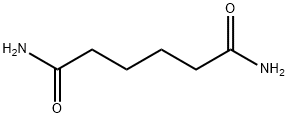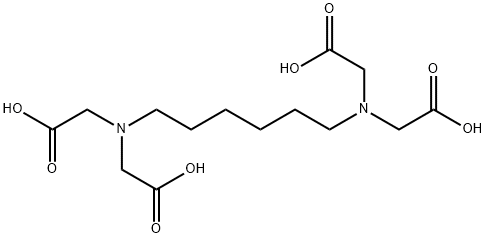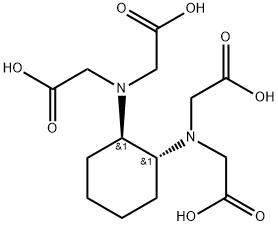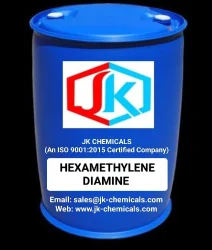Hexamethylenediamine
Synonym(s):1,6-Diaminohexane;1,6-Hexanediamine;1,6-Hexanediamine, Hexamethylenediamine;HMDA
- CAS NO.:124-09-4
- Empirical Formula: C6H16N2
- Molecular Weight: 116.2
- MDL number: MFCD00008243
- EINECS: 204-679-6
- SAFETY DATA SHEET (SDS)
- Update Date: 2025-12-17 09:50:03

What is Hexamethylenediamine?
Description
Hexamethylenediamine (formally hexane-1,6-diamine) is a colorless, low-melting solid with an important industrial use. It and adipic acid (Molecule of the Week for February 9, 2015) are the starting materials for manufacturing nylon 6,6, a polyamide used widely in textiles and plastics.
The earliest synthesis of hexamethylenediamine is attributed to Theodor Curtius and Hans Clemm, Heidelberg University (Germany) chemists, who in 1900 made it by hydrogenating adiponitrile. In 1929, biochemists Karl H. Slotta and R. Tschesche at the University of Breslau (Germany) improved this process by generating hydrogen in situ from sodium metal and ethanol.
Nylon 6,6 market value in 2018 is estimated to be more than US$3 billion; this value is expected to double by 2026. For more on the status of the nylon 6,6 industry, see the October 8, 2018, issue of Chemical & Engineering News.
Description
HMDA is a hygroscopic, colorless solid (pel-letsorflakes). Weak, fishy odor. odor thresh-old = 0.004 mg/m';Molecular weight = 116.13; Boilingpoint = 199℃; FreezingMelting point = 39- 42℃; Flashpoint= 71℃;81℃(solution);Autoi gnitiontemperature = 310℃. Explosive limits:LEL=0.7%;UEL= 6.3%. Soluble in water.
Chemical properties
Hexamethylenediamine(HMDA) is a strong organic base, e.g., a 10 % aqueous solution has a pH of 12.3 (20°C), and forms stable salts with both organic and inorganic acids. The most important salt is that produced by neutralization with adipic acid (salt strike): the so-called nylon salt or AH salt. This compound is the raw material for the preparation of nylon by thermal dehydration under vacuum.
Physical properties
Hexamethylenediamine is a colorless solid with a typical fishlike amine odor. It is very soluble in water, soluble in alcohols and aromatic solvents, and poorly soluble in aliphatic hydrocarbons.
The Uses of Hexamethylenediamine
Hexamethylenediamine is mainly used as a monomer to make nylon 6-6. Its derivative hexamethylene diisocyanate (HDI) is used in the production of polyurethane. It acts as a cross-linking agent in epoxy resins. Other applications include fiber, plastics, polyurethane coatings, lubricants, water treatment products and specialty chemicals (biocides, petroleum additives, and phenol purification).
What are the applications of Application
Hexamethylenediamine is a acrylonitrile copolymer modifier
Definition
ChEBI: Hexamethylenediamine is a C6 alkane-alpha,omega-diamine. It has a role as a human xenobiotic metabolite. It derives from a hydride of a hexane.
What are the applications of Application
Hexamethylenediamine (1,6-hexanediamine, HDA ) may be used in the preparation of the following:
polyamides and their hydrolytic and fungal degradability was investigated
mullite ceramics
methoxycarbonylation of 1,6-hexanediamine with dimethyl carbonate to form dimethylhexane-1,6-dicarbamate.
Formation of high polymers, e.g., nylon 66.
dialkyl hexamethylene-1,6-dicarbamate (AHDC), via trans-esterification reaction of HDA and alkyl carbamates (AC) using FeCl3 as catalyst.
1,6-hexanediamine modified magnetic chitosan microspheres for fast and efficient removal of toxic hexavalent chromium.
Preparation
Virtually all hexamethylenediamine is now produced by the catalytic hydrogenation of adiponitrile[111-69-3] :
NC(CH2)4CN + 4H2 → H2N(CH2)6NH2.
Reactions
Other reactions of hexamethylenediamine are typical of aliphatic amines (→ Amines, Aliphatic). The preparation of hexamethylene diisocyanate [822-06-0] by reaction with phosgene is industrially important:
H2N(CH2)6NH2+ 2COCl2 → OCN(CH2)6NCO + 4 HCl
The reaction takes place in a chlorinated aromatic solvent with a yield of 95% or more. Hexamethylene diisocyanate can also be produced by converting hexamethylenediamine to an aliphatic urethane, followed by thermal cleavage (→ Isocyanates, Organic).
General Description
Hexamethylenediamine, solution appears as a clear colorless liquid. Burns although some effort is required to ignite. Soluble in water. Corrosive to metals and tissue. Produces toxic oxides of nitrogen during combustion. Used to make nylon.
Air & Water Reactions
Water soluble.
Reactivity Profile
HEXAMETHYLENEDIAMINE is hygroscopic. Can react with strong oxidizing materials. Incompatible with acids, acid chlorides and acid anhydrides. Also incompatible with ketones, aldehydes, nitrates, phenols, isocyanates, monomers and chlorinated compounds .
Health Hazard
TOXIC; inhalation, ingestion or skin contact with material may cause severe injury or death. Contact with molten substance may cause severe burns to skin and eyes. Avoid any skin contact. Effects of contact or inhalation may be delayed. Fire may produce irritating, corrosive and/or toxic gases. Runoff from fire control or dilution water may be corrosive and/or toxic and cause pollution.
Fire Hazard
Combustible material: may burn but does not ignite readily. When heated, vapors may form explosive mixtures with air: indoors, outdoors and sewers explosion hazards. Contact with metals may evolve flammable hydrogen gas. Containers may explode when heated. Runoff may pollute waterways. Substance may be transported in a molten form.
Flammability and Explosibility
Non flammable
Contact allergens
Hexamethylenediamine is used with adipic acid in the synthesis of polyamide plastics.
Potential Exposure
HMDA is used as a textile intermedi ate; a raw material for nylon fiber and plastics; in wet strength resins; in the manufacture of oil-modified and moisture-area types of urethane coatings; in the manufac ture of polyamides for printing inks, dimer acids, and tex tiles; and as an oil and lubricant additive (probably as a corrosion inhibitor); as boiler feed water additives; also used in paints and as a curing agent for epoxy resins; mak ing adhesives.
First aid
If this chemical gets into the eyes, remove anycontact lenses at once and irrigate immediately for at least15 min, occasionally lifting upper and lower lids. Seek med-ical attention immediately. If this chemical contacts theskin, remove contaminated clothing and wash immediatelywith soap and water. Seek medical attention immediately. Ifthis chemical has been inhaled, remove from exposure,begin rescue breathing (using universal precautions, includ-ing resuscitation mask) if breathing has stopped and CPR ifheart action has stopped. Transfer promptly to a medicalfacility. When this chemical has been swallowed, get medi-cal attention. If convulsions are not present, give a glass ortwo of water or milk to dilute the substance. Do not inducevomiting. Assure that the person's airway is unobstructedand contact a hospital or poison center immediately foradvice on whether or not to inducevomiting. Medicalobservation is recommended for 24- -48 h after breathingoverexposure, as pulmonary edema may be delayed. As firstaid for pulmonary edema, a doctor or authorized paramedicmay consider administering a corticosteroid spray.
Storage
(1) Color Code- White: Corrosive or ContactHazard; Store separately in a corrosion-resistant location.(2) Color Code- -Yellow Stripe (strong reducing agent):Reactivity Hazard; Store separately in an area isolated fromflammables, combustibles, or other yellow-coded materials.Store under nitrogen. Prior to working with this chemicalyou should be trained on its proper handling and storage.Before entering confined space where this chemical may bepresent, check to make sure that an ex plosive concentrationdoes not exist. Store in a cool, dry place away from oxidi-zers, strong acids, acid chlorides, acid anhydrides, carbondioxide, and metals. Preferably store under an inert atmo-sphere in a tightly closed container.
Shipping
UN2280 Hexamethylenediamine, solid, Hazard class: 8; Labels: 8-Corrosive material. UN1783 Hexamethylenediamine, solution, Hazard class: 8; Labels: 8-Corrosive material.
Purification Methods
Crystallise it in a stream of nitrogen. It sublimes in a vacuum. [Beilstein 4 IV 1320.]
Incompatibilities
May form explosive mixture with air. The aqueous solution is a strong base and a strong reducing agent. Reacts violently with oxidizers, acids, acid chlorides; acid anhydrides; carbon dioxide acids. Reacts on contact with water forming carbon dioxide. Polymermizes in temperatures >195℃.Reacts with ethylene dichloride, organic anhy drides, isocyanates, vinyl acetate, acrylates, substituted allyls, alkylene oxides, epichlorohydrin, ketones, aldehydes, alco hols, glycols, phenols, cresols, caprolactum solution. Attacks aluminum, copper, lead, tin, zinc and alloys. Absorbs carbon dioxide and water from air. Store under Nitrogen.
Waste Disposal
Incineration; incinerator equipped with a scrubber or thermal unit to reduce nitrogen oxides emissions.
Properties of Hexamethylenediamine
| Melting point: | 42-45 °C(lit.) |
| Boiling point: | 204-205 °C |
| Density | 0.89 g/mL at 25 °C(lit.) |
| vapor density | 4 (vs air) |
| vapor pressure | 0.25 hPa (20 °C) |
| refractive index | n |
| Flash point: | 201 °F |
| storage temp. | Store below +30°C. |
| solubility | alcohol: soluble(lit.) |
| form | Solution |
| appearance | colorless crystals or clear liquid |
| pka | 11.857(at 0℃) |
| color | White, may discolor during storage |
| PH | 12.4 (100g/l, H2O, 25℃) |
| Odor | pyridine odor |
| explosive limit | 0.9-7.6%(V) |
| Water Solubility | 490 g/L (20 ºC) |
| Sensitive | Hygroscopic |
| Merck | 14,4695 |
| BRN | 1098307 |
| Exposure limits | ACGIH: TWA 0.5 ppm |
| Stability: | Stable. Combustible. Incompatible with strong oxidizing agents, strong acids, organic materials. |
| CAS DataBase Reference | 124-09-4(CAS DataBase Reference) |
| NIST Chemistry Reference | 1,6-Hexanediamine(124-09-4) |
| EPA Substance Registry System | Hexamethylenediamine (124-09-4) |
Safety information for Hexamethylenediamine
| Signal word | Danger |
| Pictogram(s) |
 Corrosion Corrosives GHS05  Exclamation Mark Irritant GHS07 |
| GHS Hazard Statements |
H314:Skin corrosion/irritation H335:Specific target organ toxicity, single exposure;Respiratory tract irritation |
| Precautionary Statement Codes |
P260:Do not breathe dust/fume/gas/mist/vapours/spray. P270:Do not eat, drink or smoke when using this product. P280:Wear protective gloves/protective clothing/eye protection/face protection. P301+P312:IF SWALLOWED: call a POISON CENTER or doctor/physician IF you feel unwell. P303+P361+P353:IF ON SKIN (or hair): Remove/Take off Immediately all contaminated clothing. Rinse SKIN with water/shower. P305+P351+P338:IF IN EYES: Rinse cautiously with water for several minutes. Remove contact lenses, if present and easy to do. Continuerinsing. |
Computed Descriptors for Hexamethylenediamine
Hexamethylenediamine manufacturer
New Products
4,4-Difluoropiperidine hydrochloride tert-butyl 9-methoxy-3-azaspiro[5.5]undecane-3-carboxylate Indole Methyl Resin N-Isopropylurea N,N-Dicyclohexylcarbodiimide(DCC) MELDRUMS ACID 5-METHYLISOXAZOLE-4-CARBOXYLIC ACID Magnessium Bis glycinate Zinc ascorbate 1-bromo-2-butyne 2-acetamidophenol 9(10H)-anthracenone Erythrosin B, 4-Piperidinopiperidine 2-((4-morpholinophenylamino) (methylthio) methylene) malononitrile 2,4-dihydroxybenzaldehyde 3-(4-morpholinophenylamino)-5-amino-1H-pyrazole-4-carbonitrile Methyl 2-methylquinoline-6-carboxylate 2,6-dichloro-4-nitropyridine 4-Bromo-2-chlorobenzonitrile 2-(benzylamino)acetic acid hydrochloride 4-(tert-Butoxycarbonylamino)but- 2-ynoic acid 3,4-dihydro-2H-benzo[b][1,4]dioxepine 1-Phenyl-1-cycloprppanecarboxylicacidRelated products of tetrahydrofuran








You may like
-
 1,6-Diaminohexane 124-09-4 98%View Details
1,6-Diaminohexane 124-09-4 98%View Details
124-09-4 -
 1,6-Diaminohexane CAS 124-09-4View Details
1,6-Diaminohexane CAS 124-09-4View Details
124-09-4 -
 Hexamethylenediamine CAS 124-09-4View Details
Hexamethylenediamine CAS 124-09-4View Details
124-09-4 -
 Hexamethylenediamine CAS 124-09-4View Details
Hexamethylenediamine CAS 124-09-4View Details
124-09-4 -
 Hexamethylenediamine CAS 124-09-4View Details
Hexamethylenediamine CAS 124-09-4View Details
124-09-4 -
 1, 6 Hexanediamine CAS No. 124-09-4View Details
1, 6 Hexanediamine CAS No. 124-09-4View Details
124-09-4 -
 HEXA METHYLENE DI AMINE, LiquidView Details
HEXA METHYLENE DI AMINE, LiquidView Details
124-09-4 -
 Hexamethylene diamine PowderView Details
Hexamethylene diamine PowderView Details
124-09-4
